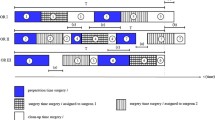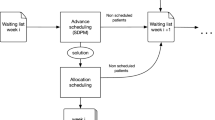Abstract
In China, day surgery has been promoted because its operation time and post-operative hospital stay are shorter than those of elective surgery. Day surgery can speed up the turnover of beds and operation rooms. Usually, the conditions of elective surgery patients are more complicated than those of day surgery patients. The development of the discipline, which means that the hospital has improved the skills of the doctors and the ability of doctors to cope with serious diseases and has increased the overall medical level of the hospital, requires surgeons to operate in some complicated elective surgeries. In the case of operating rooms and beds in short supply, there is a trade-off between the promotion of day surgery and the development of the discipline. Day surgery is relatively uncomplicated, but it requires more highly qualified surgeons. However, the development of the discipline requires surgeons to take on some complicated elective surgeris. Moreover, according to the notion of grading treatment, class-A tertiary hospitals are more suitable for patients with relatively complicated and serious conditions. In the emerging context of day surgery, highly qualified surgeons need to perform both day surgeries and elective surgeries. This paper studied how to control the admission of surgery patients. We take into account both day surgery promotion and discipline development in decision-making. A dynamic programming model was built for admission control, and a γ-adjust-threshold heuristic policy was proposed. We then compared the heuristic policy to three other policies through simulation. The results show that our heuristic policy outperforms the hospital’s target policy.









Similar content being viewed by others
References
Ma, G., and Demeulemeester, E., A multilevel integrative approach to hospital case mix and capacity planning. Comput. Oper. Res. 40(9):2198–2207, 2012.
Choi, S., and Wilhelm, W.E., On capacity allocation for operating rooms. Comput. Oper. Res. 44(44):174–184, 2014.
Dexter, F., Ledolter, J., and Watchel, R.E., Tactical decision making for selective expansion of operating room resources incorporating financial criteria and uncertainty in subspecialties' future workloads. Anesth. Analg. 100(5):1425–1432, 2005.
Gerchak, Y., Gupta, D., and Henig, M., Reservation planning for elective surgery under uncertain demand for emergency surgery. Manag. Sci. 42(3):321–334, 1996.
Blake, J.T., and Carter, M.W., A goal programming approach to strategic resource allocation in acute care hospitals. Eur. J. Oper. Res. 140(3):541–561, 2002.
Perdomo, V., Augusto, V., and Xie, X., Operating theatre scheduling using Lagrangian relaxation. Eur. J. Ind. Eng. 2(2):172–189, 2008.
Zhang, Z., Xie, X., and Geng, N., Dynamic surgery assignment of multiple operating rooms with planned surgeon arrival times. IEEE Trans. Autom. Sci. Eng. 11(3):680–691, 2014.
Zhang, Z., and Xie, X., Simulation-based optimization for surgery appointment scheduling of multiple operating rooms. IIE Trans. 47(9):998–1012, 2015.
Li, X., Rafaliya, N., Baki, M.F., and Chaouch, B.A., Scheduling elective surgeries: The tradeoff among bed capacity, waiting patients and operating room utilization using goal programming. Health Care Manag. Sci. 20:1–22, 2015.
Hachicha, H. K., and Mansour, F. Z., Two-MILP models for scheduling elective surgeries within a private healthcare facility. Health Care Manag. Sci. 19(4):1–17, 2016.
Latorre-Núñez, G., Lüer-Villagra, A., Marianov, V., Obreque, C., Ramis, F., and Neria, L., Scheduling operating rooms with consideration of all resources, post anesthesia beds and emergency surgeries. Comput. Ind. Eng. 97:248–257, 2016.
Demeulemeester, E., Beliën, J., Cardoen, B., et al., Operating room planning and scheduling[M]. Handbook of healthcare operations management. Springer, New York, pp. 121–152, 2013.
Shmueli, A., Sprung, C.L., and Kaplan, E.H., Optimizing admissions to an intensive care unit. Health Care Manag. Sci. 6:131–136, 2003.
Yang, M., Fry, M.J., and Scurlock, C., The ICU will see you now: Efficient–equitable admission control policies for a surgical ICU with batch arrivals. IIE Trans. 47(6):586–599, 2015.
Zhuang, W., and Li, M.Z.F., A new method of proving structural properties for certain class of stochastic dynamic control problems. Oper. Res. Lett. 38(5):462–467, 2010.
Author information
Authors and Affiliations
Corresponding author
Ethics declarations
Funding
This study was funded by 71,532,007 and 71,131,006.
Conflict of interest
All authors declare that they have no conflicts of interest.
Ethical approval
All procedures performed in studies involving human participants were in accordance with the ethical standards of the institutional and/or national research committee and with the 1964 Helsinki Declaration and its later amendments or comparable ethical standards.
Additional information
This article is part of the Topical Collection on Patient Facing Systems
Appendix
Appendix
Proposition 1
For each given t, R t (n) is monotonically non-decreasing and concave in n;
Proof
-
(1)
For each given t, we prove R t (n) is monotonically non-decreasing in n first.
When t = 0, R 0(n) = 0, the conclusion is clear.
When t ≠ 0, we assume R t − 1(n) is monotonically non-decreasing in n.
By Eq. (1) we have
Let \( {H}_{t-1}(n)-{H}_{t-1}\left(n-1\right)= \max \left\{{R}_{t-1}\left(n-{d}_i^{(k)}\right)+{r}_i+{f}_i\left({d}_i^{(k)}\right),{R}_{t-1}(n)-{c}_i\right\}- \max \left\{{R}_{t-1}\left(n-{d}_i^{(k)}-1\right)+{r}_i+{f}_i\left({d}_i^{(k)}\right),{R}_{t-1}\left(n-1\right)-{c}_i\right\} \).
We discuss the values of H t − 1(n) − H t − 1(n − 1) as below:
-
(a)
\( {R}_{t-1}\left(n-{d}_i^{(k)}\right)+{r}_i+{f}_i\left({d}_i^{(k)}\right)\ge {R}_{t-1}(n)-{c}_i \) and \( {R}_{t-1}\left(n-{d}_i^{(k)}-1\right)+{r}_i+{f}_i\left({d}_i^{(k)}\right)\ge {R}_{t-1}\left(n-1\right)-{c}_i \);
\( {H}_{t-1}(n)-{H}_{t-1}\left(n-1\right)={R}_{t-1}\left(n-{d}_i^{(k)}\right)-{R}_{t-1}\left(n-{d}_i^{(k)}-1\right) \);
-
∵ R t − 1(n) is monotonically non-decreasing in n
-
∴\( {R}_{t-1}\left(n-{d}_i^{(k)}\right)-{R}_{t-1}\left(n-{d}_i^{(k)}\hbox{-} 1\right)\ge 0 \) holds.
-
∴\( {H}_{t-1}(n)-{H}_{t-1}\left(n-1\right)={R}_{t-1}\left(n-{d}_i^{(k)}\right)-{R}_{t-1}\left(n-{d}_i^{(k)}-1\right)\ge 0 \) holds.
-
(b)
\( {R}_{t-1}\left(n-{d}_i^{(k)}\right)+{r}_i+{f}_i\left({d}_i^{(k)}\right)\ge {R}_{t-1}(n)-{c}_i \) and \( {R}_{t-1}\left(n-{d}_i^{(k)}-1\right)+{r}_i+{f}_i\left({d}_i^{(k)}\right)\le {R}_{t-1}\left(n-1\right)-{c}_i \);
-
∵R t − 1(n) is monotonically non-decreasing in n,
-
∴R t − 1(n) − c i ≥ R t − 1(n − 1) − c i holds;
-
∴\( {R}_{t-1}\left(n-{d}_i^{(k)}\right)+{r}_i+{f}_i\left({d}_i^{(k)}\right)\ge {R}_{t-1}(n)-{c}_i\ge {R}_{t-1}\left(n-1\right)-{c}_i\ge {R}_{t-1}\left(n-{d}_i^{(k)}-1\right)+{r}_i+{f}_i\left({d}_i^{(k)}\right) \) holds.
-
∴\( {H}_{t-1}(n)-{H}_{t-1}\left(n-1\right)={R}_{t-1}\left(n-{d}_i^{(k)}\right)+{r}_i+{f}_i\left({d}_i^{(k)}\right)-\left[{R}_{t-1}\left(n-1\right)-{c}_i\right]\ge 0 \) holds.
-
(c)
\( {R}_{t-1}\left(n-{d}_i^{(k)}\right)+{r}_i+{f}_i\left({d}_i^{(k)}\right)\le {R}_{t-1}(n)-{c}_i \) and \( {R}_{t-1}\left(n-{d}_i^{(k)}-1\right)+{r}_i+{f}_i\left({d}_i^{(k)}\right)\ge {R}_{t-1}\left(n-1\right)-{c}_i \);
-
∵ R t − 1(n) is monotonically non-decreasing in n,
-
∴\( {R}_{t-1}\left(n-{d}_i^{(k)}\right)-{R}_{t-1}\left(n-{d}_i^{(k)}-1\right)\ge 0 \) holds.
-
∵\( {R}_{t-1}\left(n-{d}_i^{(k)}\right)+{r}_i+{f}_i\left({d}_i^{(k)}\right)\le {R}_{t-1}(n)-{c}_i \) and \( {R}_{t-1}\left(n-{d}_i^{(k)}-1\right)+{r}_i+{f}_i\left({d}_i^{(k)}\right)\ge {R}_{t-1}\left(n-1\right)-{c}_i \),
-
∴\( {R}_{t-1}(n)-{c}_i\ge {R}_{t-1}\left(n-{d}_i^{(k)}\right)+{r}_i+{f}_i\left({d}_i^{(k)}\right)\ge {R}_{t-1}\left(n-{d}_i^{(k)}-1\right)+{r}_i+{f}_i\left({d}_i^{(k)}\right)\ge {R}_{t-1}\left(n-1\right)-{c}_i \) holds.
-
∴\( {H}_{t-1}(n)-{H}_{t-1}\left(n-1\right)={R}_{t-1}(n)-{c}_i-\left[{R}_{t-1}\left(n-{d}_i^{(k)}-1\right)+{r}_i+{f}_i\left({d}_i^{(k)}\right)\right]\ge 0 \) holds.
-
(d)
\( {R}_{t-1}\left(n-{d}_i^{(k)}\right)+{r}_i+{f}_i\left({d}_i^{(k)}\right)\le {R}_{t-1}(n)-{c}_i \) and \( {R}_{t-1}\left(n-{d}_i^{(k)}-1\right)+{r}_i+{f}_i\left({d}_i^{(k)}\right)\le {R}_{t-1}\left(n-1\right)-{c}_i \);
-
∵R t − 1(n) is monotonically non-decreasing in n
-
∴R t − 1(n) − R t − 1(n − 1) ≥ 0 holds.
-
∴H t − 1(n) − H t − 1(n − 1) = R t − 1(n) − R t − 1(n − 1) ≥ 0.
Based on the above four cases, H t − 1(n) − H t − 1(n − 1) ≥ 0 holds. So H t (n) is monotonically non-decreasing in n, R t (n) is monotonically non-decreasing in n.
-
(2)
For each given t, we prove R t (n) is concave in n;
When t = 0, R 0(n) − R 0(n − 1) = R 0(n − 1) − R 0(n − 2). The conclusion is clear.
We assume R t − 1(n) − R t − 1(n − 1) ≤ R t − 1(n − 1) − R t − 1(n − 2) holds.
By Eq. (4), we have \( {R}_t\left(n-1\right)-{R}_t\left(n-2\right)=\left(1-{\lambda}_t^{(1)}-{\lambda}_t^{(2)}\right)\left[{R}_{t-1}\left(n-1\right)-{R}_{t-1}\left(n-2\right)\right]+\sum_{i=1}^2{\lambda}_t^{(i)}\sum_kp\left({du}_t^{(i)}={d}_i^{(k)}\right)\left[{H}_{t-1}\left(n-1\right)-{H}_{t-1}\left(n-2\right)\right] \)
Respectively, corresponding to the above four cases of H t − 1(n) − H t − 1(n − 1):
-
(a)
\( {R}_{t-1}\left(n-{d}_i^{(k)}\right)+{r}_i+{f}_i\left({d}_i^{(k)}\right)\ge {R}_{t-1}(n)-{c}_i \) and \( {R}_{t-1}\left(n-{d}_i^{(k)}-1\right)+{r}_i+{f}_i\left({d}_i^{(k)}\right)\ge {R}_{t-1}\left(n-1\right)-{c}_i \);
-
∵\( {H}_{t-1}(n)-{H}_{t-1}\left(n-1\right)={R}_{t-1}\left(n-{d}_i^{(k)}\right)-{R}_{t-1}\left(n-{d}_i^{(k)}-1\right) \),
-
∴\( {H}_{t-1}(n)-{H}_{t-1}\left(n-1\right)-\left[{H}_{t-1}\left(n-1\right)-{H}_{t-1}\left(n-2\right)\right]={R}_{t-1}\left(n-{d}_i^{(k)}\right)-{R}_{t-1}\left(n-{d}_i^{(k)}-1\right)-\left[{R}_{t-1}\left(n-{d}_i^{(k)}-1\right)-{R}_{t-1}\left(n-{d}_i^{(k)}-2\right)\right] \),
-
∴R t − 1(n) − R t − 1(n − 1) ≤ R t − 1(n − 1) − R t − 1(n − 2),
-
∴R t − 1(n) − R t − 1(n − 1) − [R t − 1(n − 1) − R t − 1(n − 2)]≤ 0,
-
∴\( {R}_{t-1}\left(n-{d}_i^{(k)}\right)-{R}_{t-1}\left(n-{d}_i^{(k)}-1\right)-\left[{R}_{t-1}\left(n-{d}_i^{(k)}-1\right)-{R}_{t-1}\left(n-{d}_i^{(k)}-2\right)\right]\le 0 \).
-
∴Therefore, Eq. (5) R t (n) − R t (n − 1) − [R t (n − 1) − R t (n − 2)] ≤ 0 holds.
-
(b)
\( {R}_{t-1}\left(n-{d}_i^{(k)}\right)+{r}_i+{f}_i\left({d}_i^{(k)}\right)\ge {R}_{t-1}(n)-{c}_i \) and \( {R}_{t-1}\left(n-{d}_i^{(k)}-1\right)+{r}_i+{f}_i\left({d}_i^{(k)}\right)\le {R}_{t-1}\left(n-1\right)-{c}_i \)
-
∵\( {H}_{t-1}(n)-{H}_{t-1}\left(n-1\right)={R}_{t-1}\left(n-{d}_i^{(k)}\right)+{r}_i-\left[{R}_{t-1}\left(n-1\right)-{c}_i\right] \),
-
∴\( {H}_{t-1}(n)-{H}_{t-1}\left(n-1\right)-\left[{H}_{t-1}\left(n-1\right)-{H}_{t-1}\left(n-2\right)\right]={R}_{t-1}\left(n-{d}_i^{(k)}\right)-{R}_{t-1}\left(n-1\right)-\left[{R}_{t-1}\left(n-{d}_i^{(k)}-1\right)+{R}_{t-1}\left(n-2\right)\right] \),
-
∵R t − 1(n) − R t − 1(n − 1) ≤ R t − 1(n − 1) − R t − 1(n − 2),
-
∴R t − 1(n) − R t − 1(n − 1) − [R t − 1(n − 1) − R t − 1(n − 2)] ≤ 0 and \( {R}_{t-1}\left(n-{d}_i^{(k)}\right)-{R}_{t-1}\left(n-1\right)-\left[{R}_{t-1}\left(n-{d}_i^{(k)}-1\right)+{R}_{t-1}\left(n-2\right)\right]\le 0 \) holds.
Therefore, Eq. (5) R t (n) − R t (n − 1) − [R t (n − 1) − R t (n − 2)] ≤ 0 holds.
-
(c)
\( {R}_{t-1}\left(n-{d}_i^{(k)}\right)+{r}_i+{f}_i\left({d}_i^{(k)}\right)\le {R}_{t-1}(n)-{c}_i \) and \({R}_{t-1}\left(n-{d}_i^{(k)}-1\right)+{r}_i+{f}_i\left({d}_i^{(k)}\right)\ge {R}_{t-1}\left(n-1\right)-{c}_i\);
-
∵\( {H}_{t-1}(n)-{H}_{t-1}\left(n-1\right)={R}_{t-1}(n)-{c}_i-\left[{R}_{t-1}\left(n-{d}_i^{(k)}-1\right)+{r}_i\right] \)
-
∴\( {H}_{t-1}(n)-{H}_{t-1}\left(n-1\right)-\left[{H}_{t-1}\left(n-1\right)-{H}_{t-1}\left(n-2\right)\right]={R}_{t-1}(n)-{R}_{t-1}\left(n-{d}_i^{(k)}-1\right)-\left[{R}_{t-1}\left(n-1\right)-{R}_{t-1}\left(n-{d}_i^{(k)}-2\right)\right] \)
-
∵R t − 1(n) − R t − 1(n − 1) ≤ R t − 1(n − 1) − R t − 1(n − 2),
-
∴R t − 1(n) − R t − 1(n − 1) − [R t − 1(n − 1) − R t − 1(n − 2)] ≤ 0, and \( {R}_{t-1}(n)-{R}_{t-1}\left(n-{d}_i^{(k)}-1\right)-\left[{R}_{t-1}\left(n-1\right)-{R}_{t-1}\left(n-{d}_i^{(k)}-2\right)\right]\le 0 \) holds.
Therefore, Eq. (5) R t (n) − R t (n − 1) − [R t (n − 1) − R t (n − 2)] ≤ 0 holds.
-
(d)
\( {R}_{t-1}\left(n-{d}_i^{(k)}\right)+{r}_i+{f}_i\left({d}_i^{(k)}\right)\le {R}_{t-1}(n)-{c}_i \) and \( {R}_{t-1}\left(n-{d}_i^{(k)}-1\right)+{r}_i+{f}_i\left({d}_i^{(k)}\right)\le {R}_{t-1}\left(n-1\right)-{c}_i \);
-
∵H t − 1(n) − H t − 1(n − 1) = R t − 1(n) − R t − 1(n − 1),
-
∴H t − 1(n) − H t − 1(n − 1) − [H t − 1(n − 1) − H t − 1(n − 2)] = R t − 1(n) − R t − 1(n − 1) − [R t − 1(n − 1) − R t − 1(n − 2)],
-
∵R t − 1(n) − R t − 1(n − 1) ≤ R t − 1(n − 1) − R t − 1(n − 2),
-
∴R t − 1(n) − R t − 1(n − 1) − [R t − 1(n − 1) − R t − 1(n − 2)] ≤ 0,
Therefore, Eq. (5) R t (n) − R t (n − 1) − [R t (n − 1) − R t (n − 2)] ≤ 0 holds.
Based on the four cases above, R t (n) − R t (n − 1) − [R t (n − 1) − R t (n − 2)] ≤ 0 holds. That is, R t (n) − R t (n − 1) ≤ R t (n − 1) − R t (n − 2) holds. So, for each given t, R t (n) is concave in n.
From the proof (1) and (2), we get the conclusion that for each given t, R t (n) is monotonically non-decreasing and concave in n.
Proposition 2
For each given n, R t (n) is monotonically non-decreasing and concave in t and is super-modular in (t, n);
Proof
-
(1)
For each given n, we prove R t (n) is monotonically non-decreasing in t;
When n = 0, R t (0) = 0. The conclusion is clear.
When n ≠ 0, we assume for any n, R t (n − 1) is monotonically non-decreasing in t
By Eq. (1), we have
Let \( {H}_{t-1}(n)-{H}_{t-2}(n)= \max \left\{{R}_{t-1}\left(n-{d}_i^{(k)}\right)+{r}_i+{f}_i\left({d}_i^{(k)}\right),{R}_{t-1}(n)-{c}_i\right\}- \max \left\{{R}_{t-2}\left(n-{d}_i^{(k)}\right)+{r}_i+{f}_i\left({d}_i^{(k)}\right),{R}_{t-2}(n)-{c}_i\right\} \).
We discuss H t − 1(n) − H t − 2(n) in four cases as below.
-
(a)
\( {R}_{t-1}\left(n-{d}_i^{(k)}\right)+{r}_i+{f}_i\left({d}_i^{(k)}\right)\ge {R}_{t-1}(n)-{c}_i \) and \( {R}_{t-2}\left(n-{d}_i^{(k)}\right)+{r}_i+{f}_i\left({d}_i^{(k)}\right)\ge {R}_{t-2}(n)-{c}_i \);
-
∵ R t (n − 1) is monotonically non-decreasing in t
-
∴\( {R}_{t-1}\left(n-{d}_i^{(k)}\right)-{R}_{t-2}\left(n-{d}_i^{(k)}\right)\ge 0 \) holds.
-
∴\( {H}_{t-1}(n)-{H}_{t-2}(n)={R}_{t-1}\left(n-{d}_i^{(k)}\right)-{R}_{t-2}\left(n-{d}_i^{(k)}\right)\ge 0 \).
-
(b)
\( {R}_{t-1}\left(n-{d}_i^{(k)}\right)+{r}_i+{f}_i\left({d}_i^{(k)}\right)\ge {R}_{t-1}(n)-{c}_i \) and \( {R}_{t-2}\left(n-{d}_i^{(k)}\right)+{r}_i+{f}_i\left({d}_i^{(k)}\right)\le {R}_{t-2}(n)-{c}_i \);
-
∵ R t (n − 1) is monotonically non-decreasing in t
-
∴R t − 1(n) − c i ≥ R t − 2(n) − c i holds
-
∴\( {R}_{t-1}\left(n-{d}_i^{(k)}\right)+{r}_i+{f}_i\left({d}_i^{(k)}\right)\ge {R}_{t-1}(n)-{c}_i\ge {R}_{t-2}(n)-{c}_i\ge {R}_{t-2}\left(n-{d}_i^{(k)}\right)+{r}_i+{f}_i\left({d}_i^{(k)}\right) \).
-
∴\( {H}_{t-1}(n)-{H}_{t-2}(n)={R}_{t-1}\left(n-{d}_i^{(k)}\right)+{r}_i+{f}_i\left({d}_i^{(k)}\right)-\left[{R}_{t-2}(n)-{c}_i\right]\ge 0 \).
-
(c)
\( {R}_{t-1}\left(n-{d}_i^{(k)}\right)+{r}_i+{f}_i\left({d}_i^{(k)}\right)\le {R}_{t-1}(n)-{c}_i \) and \( {R}_{t-2}\left(n-{d}_i^{(k)}\right)+{r}_i+{f}_i\left({d}_i^{(k)}\right)\ge {R}_{t-2}(n)-{c}_i \);
-
∵ R t (n − 1) is monotonically non-decreasing in t
-
∴\( {R}_{t-1}\left(n-{d}_i^{(k)}\right)+{r}_i+{f}_i\left({d}_i^{(k)}\right)\ge {R}_{t-2}\left(n-{d}_i^{(k)}\right)+{r}_i+{f}_i\left({d}_i^{(k)}\right) \) holds
-
∴\( {R}_{t-1}(n)-{c}_i\ge {R}_{t-1}\left(n-{d}_i^{(k)}\right)+{r}_i+{f}_i\left({d}_i^{(k)}\right)\ge {R}_{t-2}\left(n-{d}_i^{(k)}\right)+{r}_i+{f}_i\left({d}_i^{(k)}\right)\ge {R}_{t-2}(n)-{c}_i \) holds.
-
∴\( {H}_{t-1}(n)-{H}_{t-2}(n)={R}_{t-1}(n)-{c}_i-\left[{R}_{t-2}\left(n-{d}_i^{(k)}\right)+{r}_i+{f}_i\left({d}_i^{(k)}\right)\right]\ge 0 \).
-
(d)
\( {R}_{t-1}\left(n-{d}_i^{(k)}\right)+{r}_i+{f}_i\left({d}_i^{(k)}\right)\le {R}_{t-1}(n)-{c}_i \) and \( {R}_{t-2}\left(n-{d}_i^{(k)}\right)+{r}_i+{f}_i\left({d}_i^{(k)}\right)\le {R}_{t-2}(n)-{c}_i \);
-
∵ R t (n − 1) is monotonically non-decreasing in t,
-
∴ R t − 1(n) − R t − 2(n) ≥ 0 holds,
-
∴H t − 1(n) − H t − 2(n) = R t − 1(n) − R t − 2(n) ≥ 0;
Based on the four cases,R t (n) − R t (n − 1) − [R t (n − 1) − R t (n − 2)] ≤ 0 holds. Therefore, Eq. (6) is greater than or equal to 0. That is,R t (n) − R t − 1(n) ≥ 0. So R t (n) is monotonically non-decreasing in t.
-
(2)
Then, we prove that for each given n, R t (n) is super-modular in (t, n). According to definition 1, we should prove R t (n) − R t (n − 1) ≥ R t − 1(n) − R t − 1(n − 1).
By Eq. (2) \( {R}_t(n)-{R}_{t-1}(n)=-{\lambda}_t^{(1)}{c}_1-{\lambda}_t^{(2)}{c}_2+\sum_{i=1}^2{\lambda}_t^{(i)}\sum_kp\left({du}_t^{(i)}={d}_i^{(k)}\right) \max \left\{{r}_i+{f}_i\left({d}_i^{(k)}\right)+{c}_i-\left[{R}_{t-1}(n)-{R}_{t-1}\left(n-{d}_i^{(k)}\right)\right],0\right\} \),
-
∴\( \begin{array}{l}{R}_t(n)-{R}_{t-1}(n)-\left[{R}_t\left(n-1\right)-{R}_{t-1}\left(n-1\right)\right]=\sum_{i=1}^2{\lambda}_t^{(i)}\sum_kp\left({du}_t^{(i)}={d}_i^{(k)}\right) \max \left\{{r}_i+{f}_i\left({d}_i^{(k)}\right)+{c}_i-\left[{R}_{t-1}(n)-{R}_{t-1}\left(n-{d}_i^{(k)}\right)\right],0\right\}\hfill \\ {}-\sum_{i=1}^2{\lambda}_t^{(i)}\sum_kp\left({du}_t^{(i)}={d}_i^{(k)}\right) \max \left\{{r}_i+{f}_i\left({d}_i^{(k)}\right)+{c}_i-\left[{R}_{t-1}(n)-{R}_{t-1}\left(n-{d}_i^{(k)}\right)\right],0\right\}\hfill \end{array} \).
-
∵ R t (n) is concave in n
-
∴\( {R}_{t-1}(n)-{R}_{t-1}\left(n-{d}_i^{(k)}\right)\le {R}_{t-1}\left(n-1\right)-{R}_{t-1}\left(n-{d}_i^{(k)}-1\right) \);
-
∴\( {r}_i+{f}_i\left({d}_i^{(k)}\right)+{c}_i-\left[{R}_{t-1}(n)-{R}_{t-1}\left(n-{d}_i^{(k)}\right)\right]\ge {r}_i+{f}_i\left({d}_i^{(k)}\right)+{c}_i-\left[{R}_{t-1}\left(n-1\right)-{R}_{t-1}\left(n-{d}_i^{(k)}-1\right)\right] \)
-
∴R t (n) − R t − 1(n) − [R t (n − 1) − R t − 1(n − 1)] ≥ 0.
-
∴ R t (n) is super-modular in (t, n).
-
(3)
Last, we prove that for each given n, R t (n) is concave in t. That is, we should prove R t (n) − R t − 1(n) ≤ R t − 1(n) − R t − 2(n).
-
(3)
-
∵ R t (n) is super-modular in (t, n)and by Eq. (2)
-
∴R t (n) − R t − 1(n) ≤ R t − 1(n) − R t − 2(n) holds
-
∴For each given n, R t (n) is concave in t.
From the proof (1), (2) and (3), we can get the conclusion that for each given n, R t (n) is monotonically non-decreasing and concave in t and is super-modular in (t, n);
Theorem 1
For any time t(t = T, T − 1, … , 1), if the remaining capacity of the surgeon satisfies \( n\ge {n}_t^{(i)} \), then the surgeon should accept the booking request of type i patients on the nearest main surgery day, but if the remaining capacity of the surgeon satisfies \( n<{n}_t^{(i)} \), then the surgeon should reject the booking request of type i patients on the nearest main surgery day.
Proof
From Eq. (2), if and only when \( {r}_i+{f}_i\left({d}_i^{(k)}\right)+{c}_i\ge {R}_{t-1}(n)-{R}_{t-1}\left(n-{d}_i^{(k)}\right) \), the new surgery request will be accepted.
Theorem 2
\( {n}_t^{(i)} \) is monotonically non-decreasing in t.
Proof
-
∵ R t (n) is super-modular in (t, n), \( {R}_{t-1}(n)-{R}_{t-1}\left(n-{d}_i^{(k)}\right)\ge {R}_{t-2}(n)-{R}_{t-2}\left(n-{d}_i^{(k)}\right) \) holds
-
∴\( {n}_t^{(i)}\ge {n}_{t-1}^{(i)} \), that is \( {n}_t^{(i)} \) is monotonically non-decreasing in t.
Rights and permissions
About this article
Cite this article
Luo, L., Luo, Y. & Qin, C. Admission Control Policies for Surgery Patients. J Med Syst 41, 131 (2017). https://doi.org/10.1007/s10916-017-0764-x
Received:
Accepted:
Published:
DOI: https://doi.org/10.1007/s10916-017-0764-x




